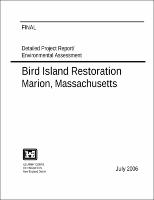Please use this identifier to cite or link to this item:
https://hdl.handle.net/11681/41446Full metadata record
| DC Field | Value | Language |
|---|---|---|
| dc.contributor.author | United States. Army. Corps of Engineers. New England District | - |
| dc.date.accessioned | 2021-08-09T19:38:57Z | - |
| dc.date.available | 2021-08-09T19:38:57Z | - |
| dc.date.issued | 2006-07 | - |
| dc.identifier.uri | https://hdl.handle.net/11681/41446 | - |
| dc.description | Detailed Project Report and Environmental Assessment | en_US |
| dc.description.abstract | Bird Island, in the town of Marion, Massachusetts, provides critical nesting habitat for Roseate and Common Terns. It is one of a number of islands in Buzzards Bay and Nantucket Sound that have been among the most important nesting sites in the United States for Roseate Terns and Common Terns. The northeastern population of the Roseate Tern is listed as endangered at both the federal and state levels of jurisdiction; Common Terns are listed as a Species of Special Concern in Massachusetts. Between 1920 and 1972, many tern nesting islands in Buzzards Bay were overrun by gulls, forcing the majority of the terns to Bird Island, so that Bird Island now supports critical nesting habitat for 22 percent of the Northeast population of Roseate Terns. The majority of the Northeast population of Roseate Tern is concentrated at just three sites: Great Gull Island, New York; Bird Island, Marion; and Ram Island, Mattapoisett, Massachusetts. Bird Island also supports a stone and masonry lighthouse, which is listed on the National Register of Historic Places. Bird Island measures approximately 3 acres in size, of which 1.5 acres of the island is above the elevation of the Mean Spring High Water tide. The island is surrounded by a deteriorating revetment, which has allowed waves to erode its surface, lowering the ground elevation and changing it from sand and gravel with low herbaceous vegetation to salt marsh and salt pannes. This habitat degradation has reduced the area available for tern nesting. The limited nesting area on Bird Island forces Roseate Terns to compete with more aggressive Common Terns for nest sites. This Detailed Project Report and Environmental Assessment, prepared under the authority of Section 206 of the Water Resources Development Act of 1996, explores options to: 1. Restore the revetment at Bird Island to reduce or eliminate erosion of the nesting substrate 2. Restore suitable nesting substrate and vegetation for tern nesting on Bird Island. This report considers three alternatives (including the No Action Alterative) to restore tern nesting habitat on Bird Island. | en_US |
| dc.description.sponsorship | United States. Army. Corps of Engineers. | en_US |
| dc.format.extent | 98 pages / 1.72 MB | - |
| dc.format.medium | - | |
| dc.language.iso | en_US | en_US |
| dc.publisher | United States. Army. Corps of Engineers. New England District. | en_US |
| dc.rights | Approved for Public Release; Distribution is Unlimited | - |
| dc.source | This Digital Resource was created in Microsoft Word and Adobe Acrobat | - |
| dc.subject | Marion (Mass.) | en_US |
| dc.subject | Restoration ecology | en_US |
| dc.subject | Environmental protection | en_US |
| dc.subject | Environmental management | en_US |
| dc.title | Final Detailed Project Report/Environmental Assessment : Bird Island Restoration, Marion, Massachusetts | en_US |
| dc.type | Report | en_US |
| Appears in Collections: | Environmental Documents | |
Files in This Item:
| File | Description | Size | Format | |
|---|---|---|---|---|
| Bird Island Restoration DPR-EAFinal.pdf | 1.72 MB | Adobe PDF |  View/Open |